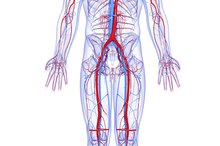Types of IV Catheters
Intravenous or IV therapy is beneficial for several conditions and medical situations including dehydration, nutrition, shock, surgery, blood transfusions, chemotherapy and medication administration. There are many types and brands of IV access catheters, and NursingCenter.com explains they fall under two designations, peripheral and central 13.
Peripheral
The most common type of intravenous catheter is designed for peripheral access 2. This is the IV line commonly put into the hand or forearm when a patient is admitted to the hospital. It is short, approximately 3/4- to 1-inch long, and is inserted into a vein by a nurse. Peripheral IVs come in various sizes, ranging from size 24 gauge or the smallest to size 14 gauge, the largest. Cypress College in California describes two types of peripheral IV devices 4. The most common is the over-the-needle catheter. This is inserted into a vein via a needle that has a plastic catheter around it; the needle is withdrawn, leaving the plastic catheter in the vein. The hub of that catheter is attached to IV tubing, or a protective cap is applied. The second type of peripheral IV catheter is a steel needle variation, often called a "butterfly" due to the wing-like plastic tubes at the base of the needle. These are always small gauge, and used for infants, blood draws and for smaller veins.
- The most common type of intravenous catheter is designed for peripheral access 2.
- The hub of that catheter is attached to IV tubing, or a protective cap is applied.
Midline Peripheral Catheter
Types of Central Venous Catheters
Learn More
Another type of IV catheter is called a midline, which is defined by NursingCenter.com as a catheter that is from 3- to 10-inches long, and inserted by a trained nurse in the arm near the inside of the elbow. This is threaded up inside the vein, with the tip not extending past the arm pit, or axilla. The chances of dislodging this IV access as compared to a peripheral one are lower, as the catheter is very soft and well imbedded in the vein. These catheters typically last for about four to six weeks. The tip of this catheter reaches a much larger vein, causing less irritation.
- Another type of IV catheter is called a midline, which is defined by NursingCenter.com as a catheter that is from 3- to 10-inches long, and inserted by a trained nurse in the arm near the inside of the elbow.
- The chances of dislodging this IV access as compared to a peripheral one are lower, as the catheter is very soft and well imbedded in the vein.
Peripherally Inserted Central Catheter
A peripherally inserted central catheter, or PICC, is a flexible catheter that is put into the elbow vein much like the midline catheter. The difference is that this catheter is longer and guided into the vena cava, which leads into the heart, according to DrugInfo.com. For this reason, it is called a central catheter, meaning the fluid and medications infused go into the central circulation immediately.
Central Venous Catheter
Types of Syringes & Needles
Learn More
TheBody.com describes central venous catheters as those that are inserted by a physician through a vein in the neck, upper chest or anterior chest, with the tip in the vena cava of the heart 3. NursingCenter.com states that there are actually four types of central catheters: one is the PICC, while the others include a non-tunneled external catheter, a tunneled external catheter or an implanted port 13. The latter two catheters are surgically placed.
Related Articles
References
- Drugs.com: PICC and Mildine Catheters
- Nursing Center.com: Choosing the Right Intravenous Catheter
- The Body.com: Types of IV Catheters
- Håkansson MÅ. Reuse versus single-use catheters for intermittent catheterization: what is safe and preferred? Review of current status. Spinal Cord. 2014;52(7):511-6. doi:10.1038/sc.2014.79
- National Clinical Guideline Centre (UK), Royal College of Physicians (UK). Long term urinary catheters. In: Infection: prevention and control of healthcare-associated infections in primary and community care. London: National Clinical Guideline Centre, 2012.
- Willette PA, Coffield S. Current trends in the management of difficult urinary catheterizations. West J Emerg Med. 2012;13(6):472-8. doi:10.5811/westjem.2011.11.6810
- Cortese YJ, Wagner VE, Tierney M, Devine D, Fogarty A. Review of catheter-associated urinary tract infections and urinary tract models. J Healthc Eng. 2018;2018:2986742. doi:10.1155/2018/2986742
- Urinary catheter types and being part of the insertion team. Agency for Healthcare Research and Quality. Updated April 2017.
- Guide to implementing a program to reduce catheter-associated urinary tract infections in long-term care. Agency for Healthcare Research and Quality. Published March 2017.
- Urinary Catheters. Medline Plus. Updated January 6, 2020.
- Infection control: catheter-associated urinary tract infections. Summary of recommendations. Centers for Disease Control and Prevention. Updated November 5, 2015.
- Feneley RC, Hopley IB, Wells PN. Urinary catheters: history, current status, adverse events and research agenda [published correction appears in J Med Eng Technol. 2016;40(2):59]. J Med Eng Technol. 2015;39(8):459–470. doi:10.3109/03091902.2015.1085600
- Meddings J, Saint S, Fowler KE, et al. The Ann Arbor criteria for appropriate urinary catheter use in hospitalized medical patients: results obtained by using the RAND/UCLA appropriateness method. Ann Intern Med. 2015;162(9 Suppl):S1-34. doi:10.7326/M14-1304
Writer Bio
Rhonda Merritt started freelance writing in 2010. She is a registered nurse specializing in cardiac rehabilitation and cardiac care. Merritt has her personal fitness coach certification and is a certified CPR instructor. She holds a Bachelor of Science in nursing. Merritt graduated from Edinboro University in 1988.








